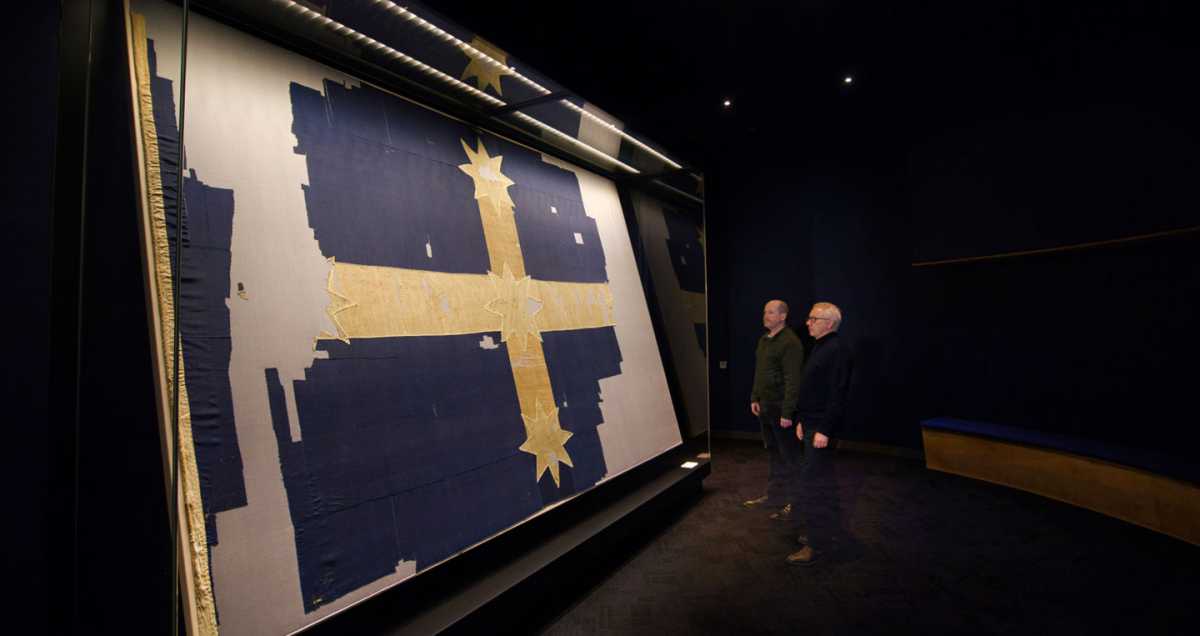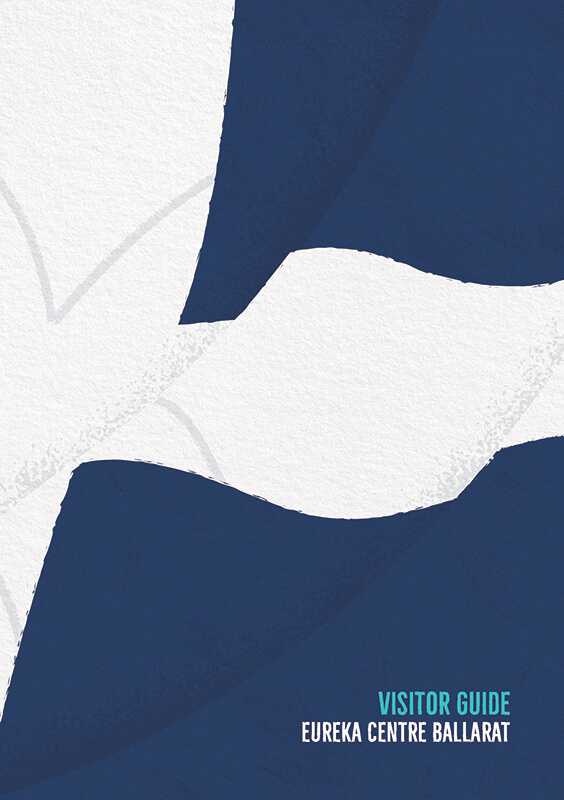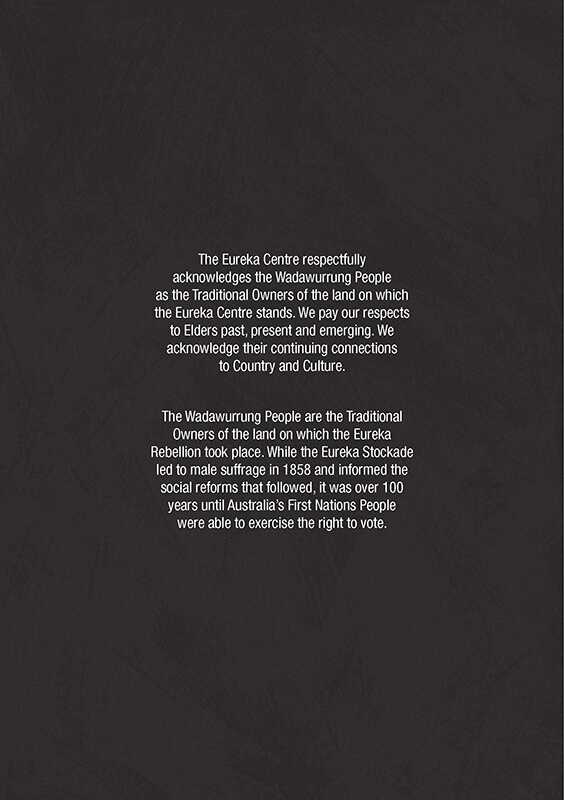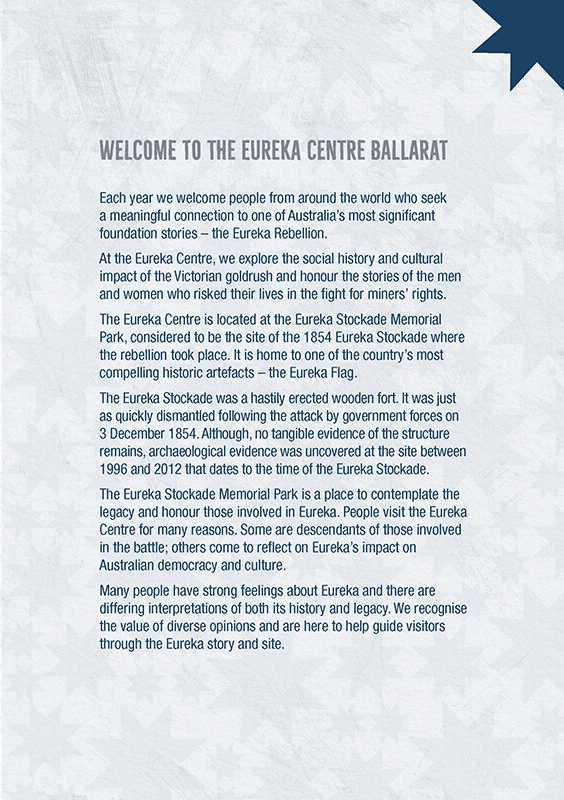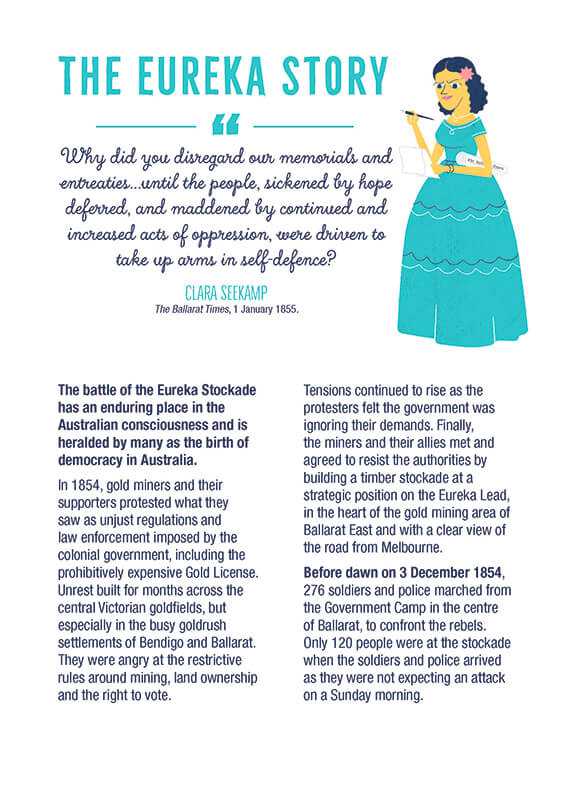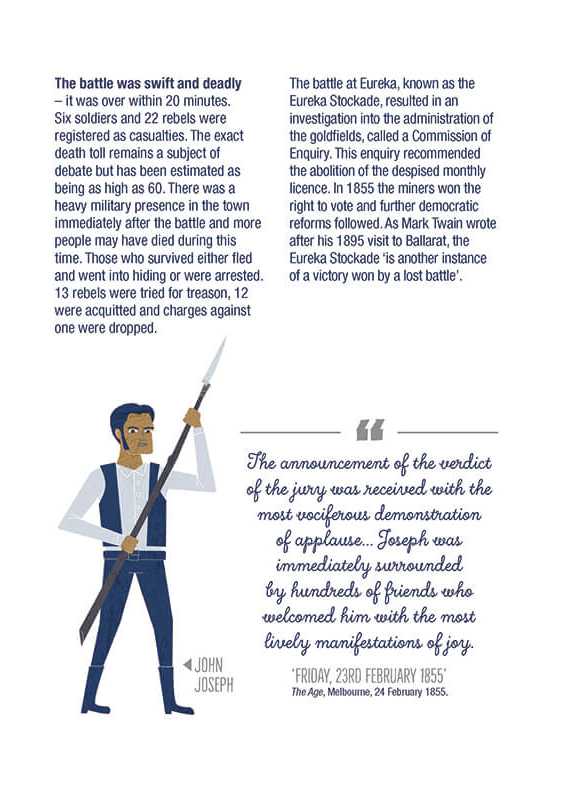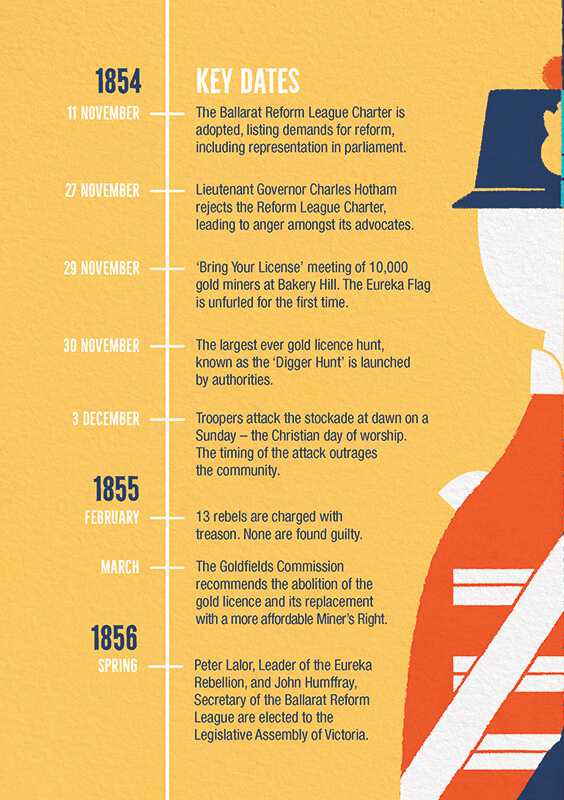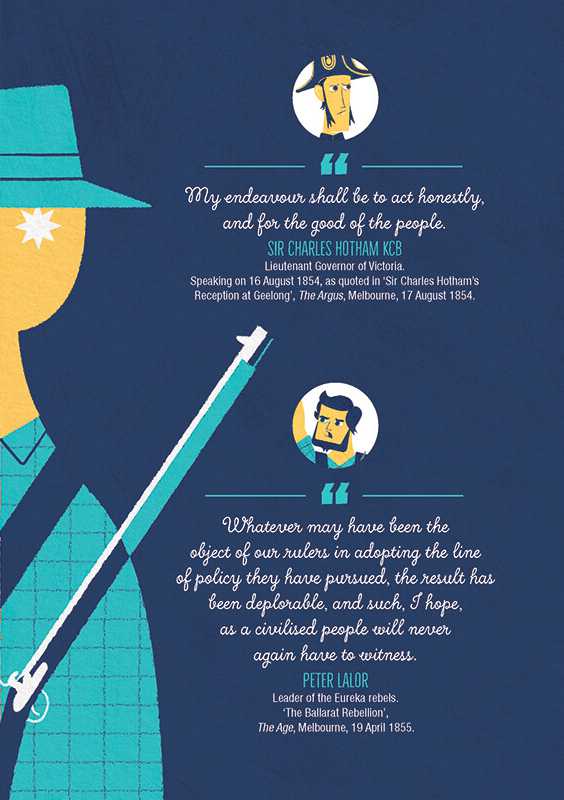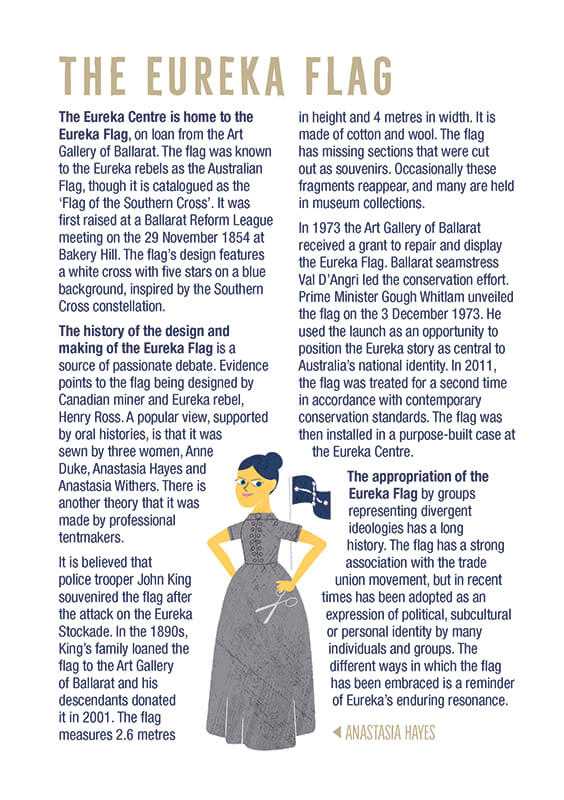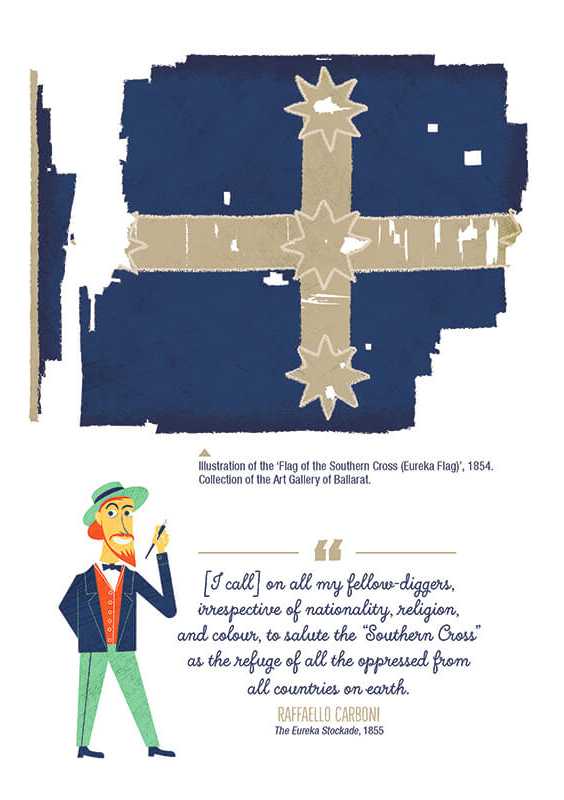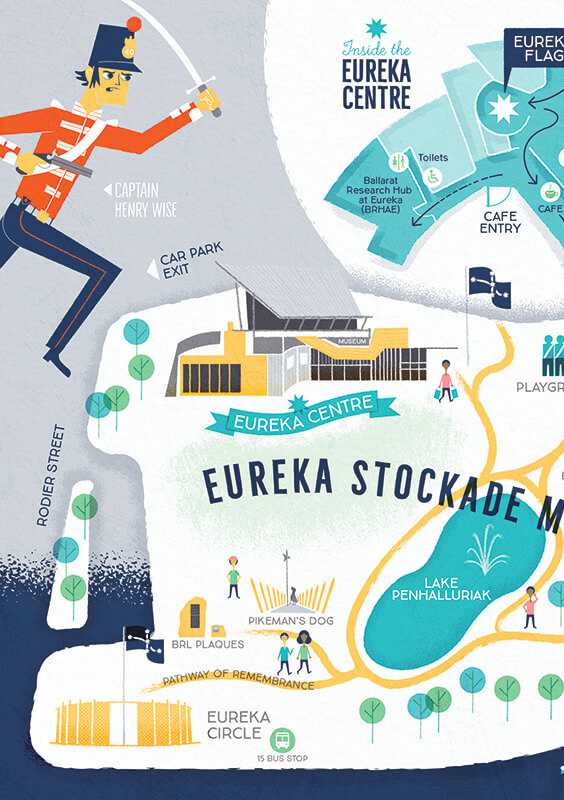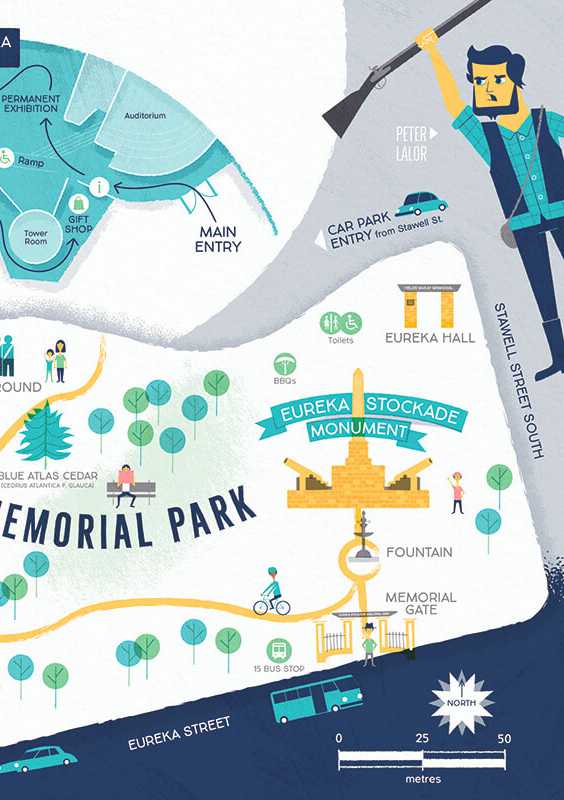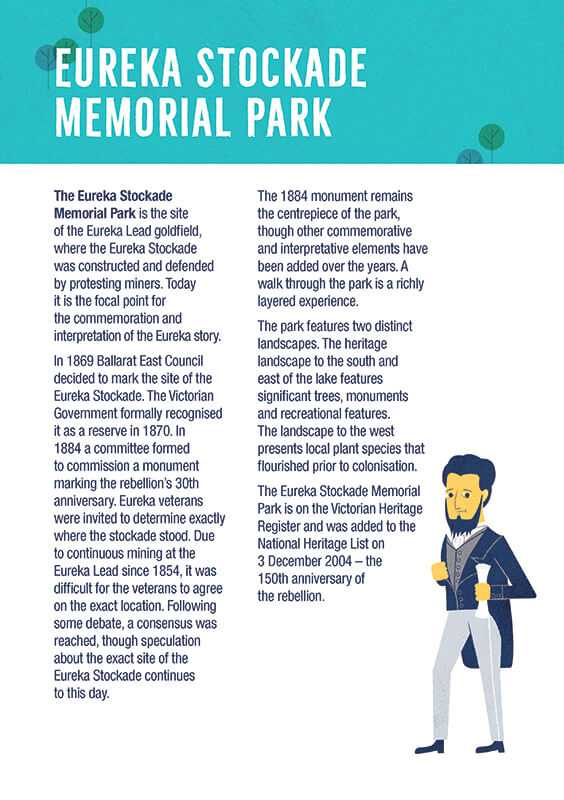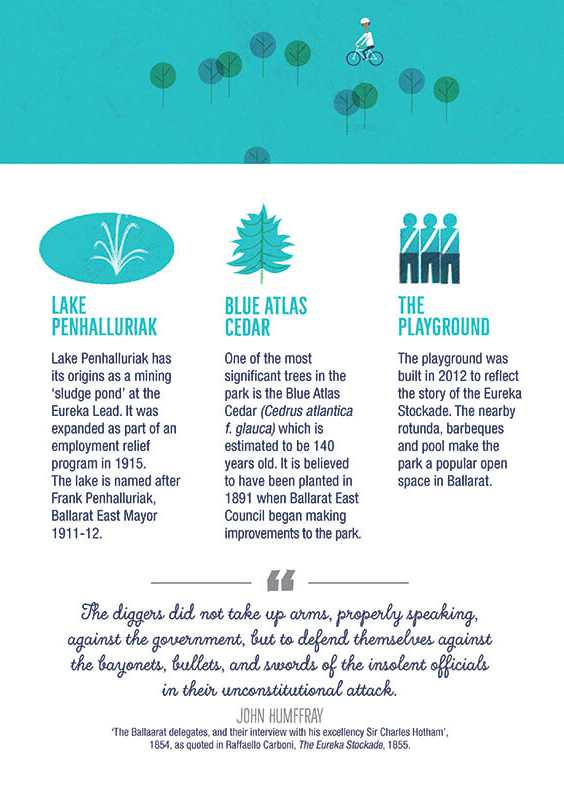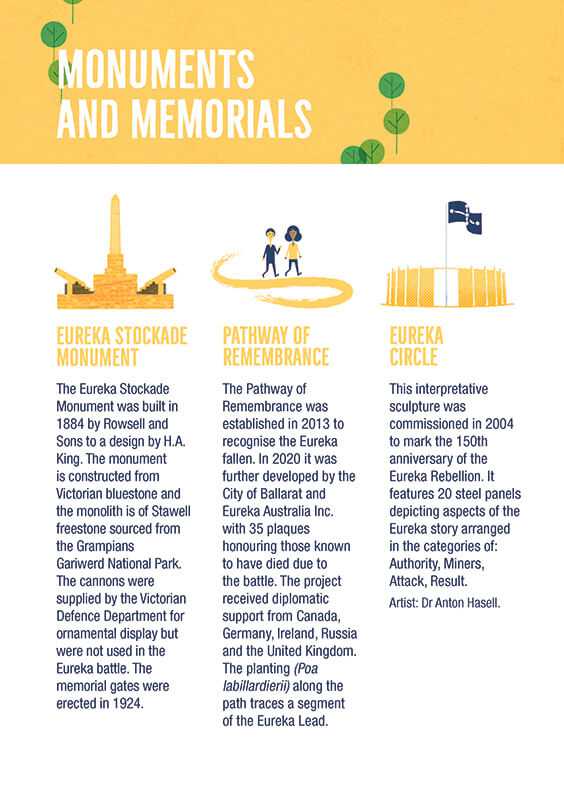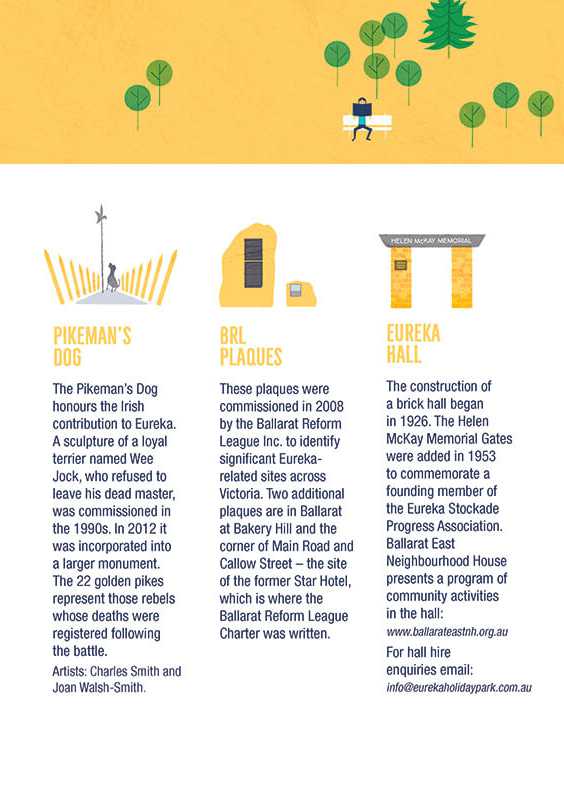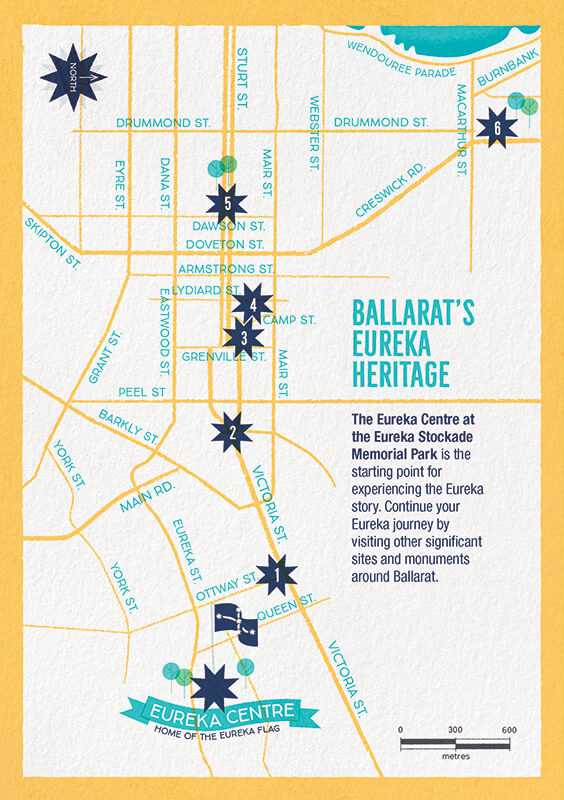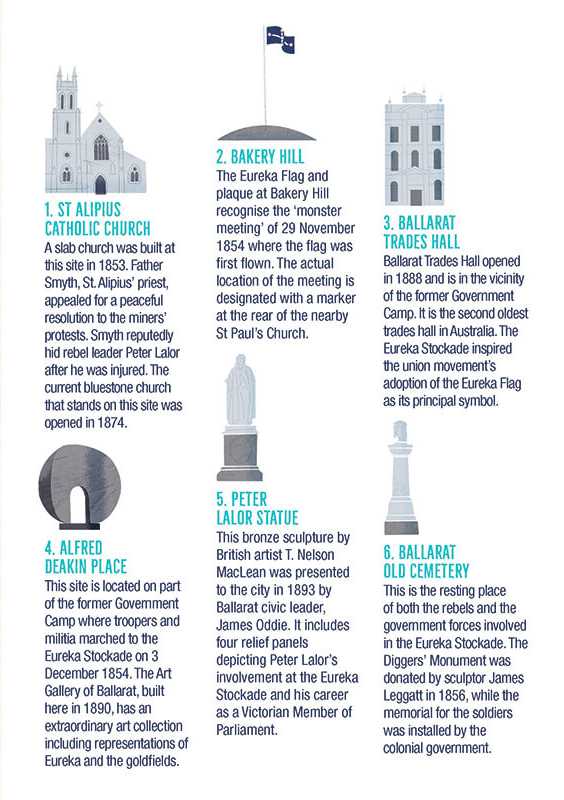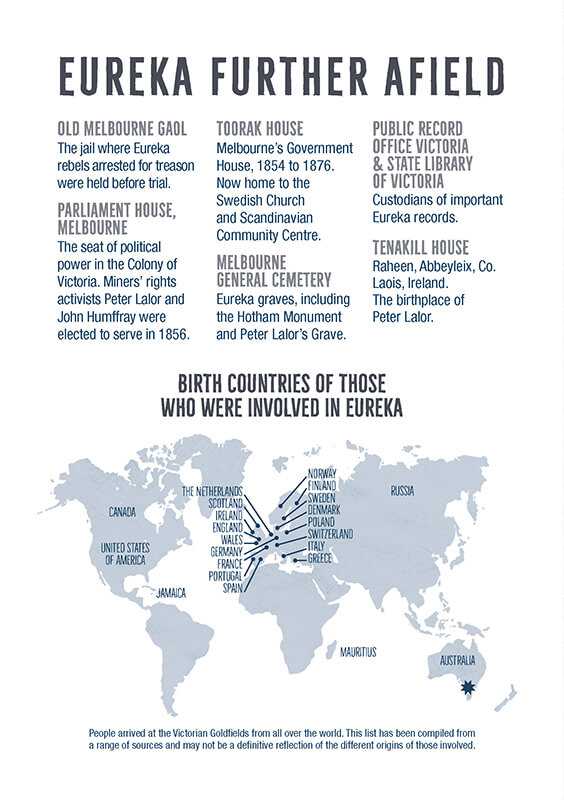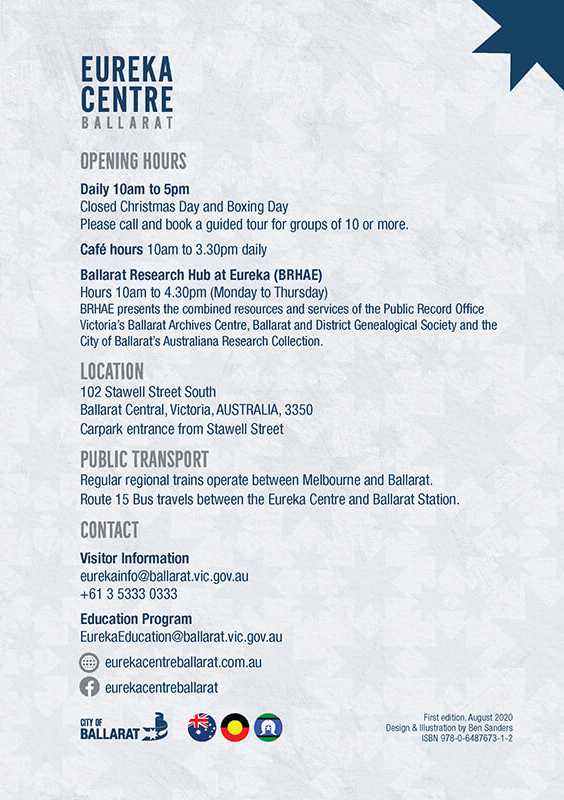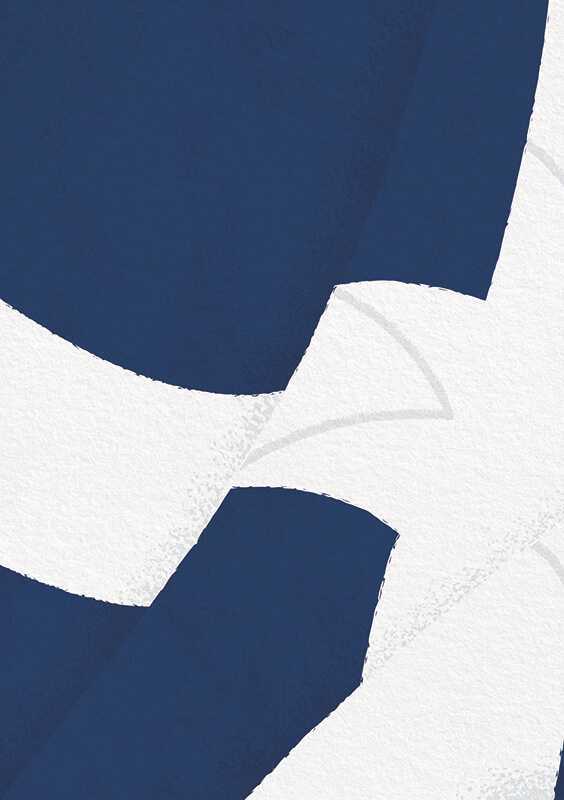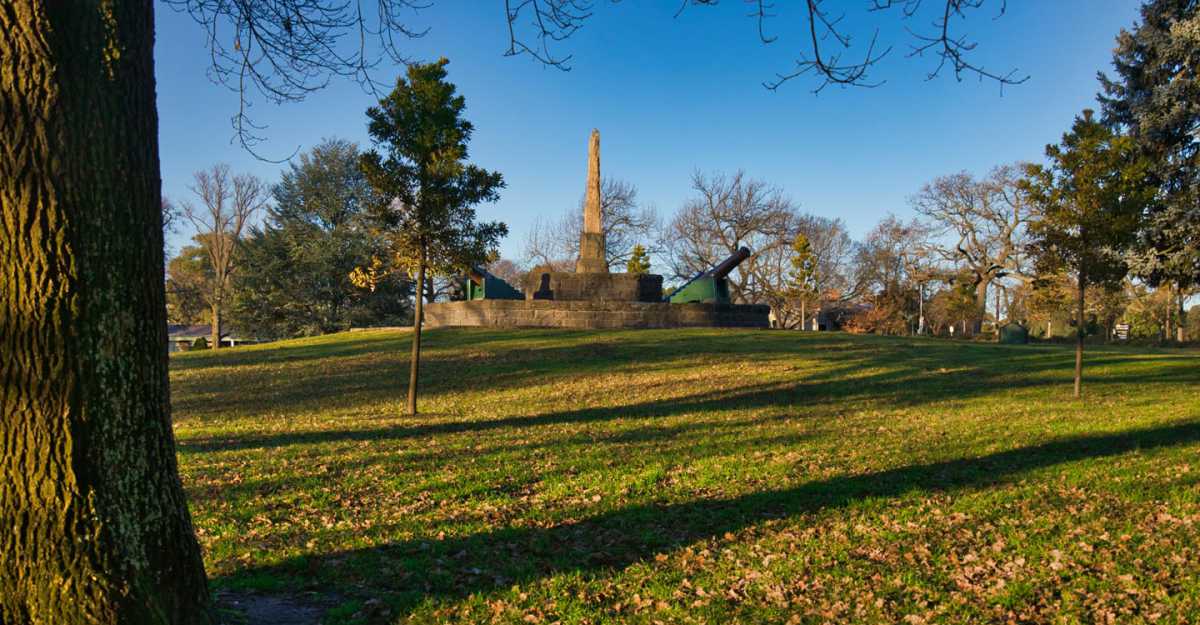Eureka Centre Ballarat
Welcome to the Eureka Centre Ballarat.
Each year we welcome people from around the world who seek a meaningful connection to one of Australia’s most significant foundation stories – the Eureka Rebellion.
At the Eureka Centre, we explore the social history and cultural impact of the Victorian gold rush and honour the stories of the men and women who risked their lives in the fight for miners’ rights.
Eureka Centre is located at the Eureka Stockade Memorial Park, considered to be the site of the 1854 Eureka Stockade where the rebellion took place. It is home to one of Australia’s most compelling historic artefacts – the Eureka Flag.
The Eureka Stockade Memorial Park is a place to contemplate the events of Eureka. The many layers of Eureka commemoration are reflected throughout the park in its significant trees, interpretive plaques and monuments that honour those involved in Eureka Stockade.
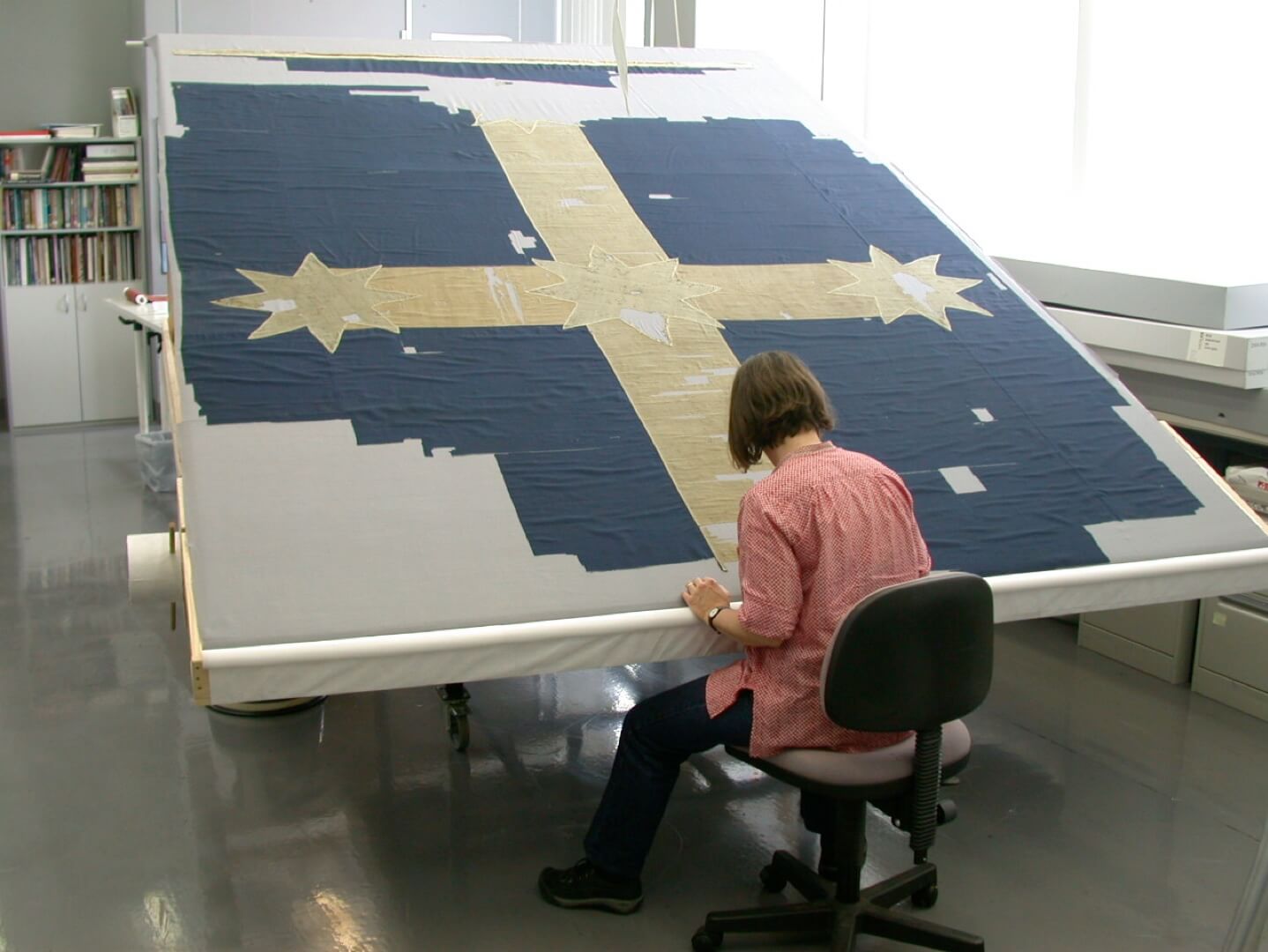
The Eureka Stockade was a hastily erected wooden fort. It was just as quickly dismantled following the attack by government forces on 3 December 1854. Therefore, no tangible evidence of the structure remains. However, significant archaeological evidence was uncovered at the site between 1996 and 2012 that dates to the time of the Eureka Stockade.
People visit the Eureka Centre for many reasons. Some are descendants of those involved in the battle, others come to reflect on Eureka’s profound impact on Australian democracy and culture.
Many people have strong feelings about Eureka; there are differing interpretations of both its history and legacy. We recognise the value of diverse opinions and are here to help guide visitors through the Eureka story and site experience.
-
Eureka Stockade Memorial Park
The Eureka Stockade Memorial Park is the site of the Eureka Lead goldfield, where the Eureka Stockade was constructed and defended by protesting miners. Today it is the focal point for the commemoration and interpretation of the Eureka story.
In 1869 Ballarat East Council decided to mark the site of the Eureka Stockade. The Victorian Government formally recognised it as a reserve in 1870. In 1884 a committee formed to commission a monument marking the Rebellion’s 30th anniversary. Eureka veterans were invited to determine exactly where the stockade stood. Due to continuous mining at the Eureka Lead since 1854, it was difficult for the veterans to agree on the exact location. Following some debate, a consensus was reached, though speculation about the exact site of the Eureka Stockade continues to this day.
The 1884 monument remains the centrepiece of the park, though other commemorative and interpretative elements have been added over the years. A walk through the park is a richly layered experience.
The park features two distinct landscapes. The heritage landscape to the south and east of the lake features significant trees, monuments and recreational features. The landscape to the west presents local plant species that flourished prior to colonisation.
The Eureka Stockade Memorial Park is on the Victorian Heritage Register and was added to the National Heritage List on 3 December 2004 – the 150th anniversary of the Stockade.
-
Eureka - Ballarat and Beyond
Eureka Centre Ballarat is located at the Eureka Stockade Memorial Park and is the starting point for experiencing the Eureka story. You can continue your Eureka journey by visiting other significant sites and monuments in Ballarat and beyond.
St Alipius Catholic Church
A slab church was built at this site in 1853. Father Smyth, St. Alipius’ priest, appealed for a peaceful resolution to the miners' protests. Fr. Smyth reputedly hid rebel leader Peter Lalor after he was injured. The current bluestone church that stands on this site was opened in 1874.Bakery Hill
The Eureka Flag and plaque at Bakery Hill recognise the ‘monster meeting’ of 29 November 1854 where the flag was first flown. The actual location of the meeting is designated with a marker at the rear of the nearby St Paul’s Church.Alfred Deakin Place
This site is located on part of the former Government Camp where troopers and militia marched to the Eureka Stockade on 3 December 1854. The Art Gallery of Ballarat, built here in 1890, has an extraordinary art collection including representations of Eureka and the goldfields.Ballarat Trades Hall
Ballarat Trades Hall opened in 1888 and is in the vicinity of the former Government Camp. It is the second oldest trades hall in Australia. The Eureka Stockade inspired the union movement’s adoption of the Eureka Flag as its principal symbol.Peter Lalor Statue
This bronze sculpture by British artist T. Nelson MacLean was presented to the city in 1893 by Ballarat civic leader, James Oddie. It includes four relief panels depicting Peter Lalor’s involvement at the Eureka Stockade and his career as a Victorian Member of Parliament.Ballarat Old Cemetery
This is the resting place of both the miners and the government forces involved in the Eureka Stockade. The Diggers’ Monument was donated by sculptor James Leggatt in 1856, while the memorial for the soldiers was installed by the colonial Victorian Government in 1879.Eureka Further Afield
- Melbourne General Cemetery: Eureka graves including the Hotham Monument and Peter Lalor’s Grave.
- Parliament House, Melbourne: The seat of political power in the Victorian Colony. Miners rights activists Peter Lalor and John Humffray were elected to serve in 1856.
- Old Melbourne Gaol: The jail where Eureka rebels arrested for treason were held before trial.
- Toorak House – Melbourne’s First Government House 1854-1876: Now houses the Swedish Church and Scandinavian Community Centre.
- State Library of Victoria Honour Roll. While there: Visit the site of the Magistrates Court (original 1842-3 building demolished. Current building constructed 1910 now RMIT).
- Public Record Office Victoria is the custodian of important Eureka records.
- The Tenakill Lalor House, Raheen, Abbeyleix, Co. Laois, Ireland: The birthplace of Peter Lalor.
-
The Eureka Story
The battle of the Eureka Stockade is heralded by many as the birth of democracy in Australia and has an enduring place in the Australian consciousness.
In 1854, gold miners and their supporters protested what they saw as unjust regulations and law enforcement imposed by the colonial government, including the prohibitively expensive gold licence. Unrest built for months across the central Victorian goldfields, but especially in the busy goldrush settlements of Bendigo and Ballarat. They were angry at the restrictive rules around mining, land ownership and the right to vote.
Tensions continued to rise as the protesters felt the government was ignoring their demands. Finally, the miners and their allies met and agreed to resist the authorities by building a timber stockade at a strategic position on the Eureka Lead, in the heart of the gold mining area of Ballarat East and with a clear view of the road from Melbourne.
Before dawn on 3 December 1854, 276 British soldiers and police marched from the government camp in the centre of Ballarat, to confront the rebels. Only 120 people were at the stockade when the soldiers and police arrived as they were not expecting an attack on a Sunday morning.
The battle was swift and deadly – it was over within 20 minutes. Six soldiers were killed, and 22 rebels were registered as casualties. The exact death toll remains a subject of debate but has been estimated as being as high as 60. There was a heavy military presence in the town immediately after the battle and more people may have died during this time. Those who survived either fled and went into hiding or were arrested. Thirteen rebels were tried for treason, twelve were acquitted and charges against one were dropped.
The battle at Eureka, known as the Eureka Stockade, resulted in an investigation into the administration of the goldfields, called a ‘Commission of Enquiry’. This enquiry recommended the abolition of the despised monthly miners’ licence. In 1855 the miners won the right to vote and further democratic reforms followed. As Mark Twain wrote after his 1895 visit to Ballarat, the Eureka Stockade ‘…is another instance of a victory won by a lost battle’.
-
The Eureka Flag
Eureka Centre is home to the Eureka Flag on loan from the Art Gallery of Ballarat. The flag was known to the Eureka rebels as the Australian Flag, though it is recorded in the Gallery’s collection as ‘The Flag of the Southern Cross’. It was first raised at a Ballarat Reform League meeting on the 29 November 1854 at Bakery Hill and then at the Eureka Stockade. The flag’s design features a white cross with four stars on a blue background, inspired by the Southern Cross constellation.
The history of the design and making of the Eureka Flag is a source of passionate debate. Evidence points to the flag being designed by Canadian miner and Eureka rebel, Henry Ross. A popular view, supported by oral histories, is that it was sewn by three women, Anne Duke, Anastasia Hayes and Anastasia Withers possibly at St Alipius Catholic Parish. There is another theory that it was made by professional tentmakers.
It is believed that police trooper John King souvenired the flag following the attack on the Eureka Stockade. In the 1890s, King’s family loaned the flag to the Art Gallery of Ballarat and his descendants donated it in 2001. The flag measures 2.6 metres in height and 4 metres in width. It is made of cotton and wool. The flag has missing sections that were cut off and given as souvenirs. From time to time, these fragments reappear, and many are held in museum collections.
In 1973 the Art Gallery of Ballarat received a grant to repair and display the Eureka Flag. Ballarat seamstress Val D’Angri led the conservation effort. Australia’s 21st Prime Minister, E. Gough Whitlam unveiled the flag at the Gallery on Eureka Day, 3 December 1973. He used the launch as an opportunity to position the Eureka story as central to Australia’s national identity. In 2011, the flag was assessed and treated for a second time in accordance with contemporary conservation standards. The flag returned to Ballarat in 2013 and was installed in a purpose-built case at the Eureka Centre.
The appropriation of the Eureka Flag by groups representing divergent ideologies has a long history. The flag has a strong association with the trade union movement, but in recent times has been adopted as an expression of political, subcultural or personal identity by many individuals and groups. The different ways in which the flag has been embraced is a reminder of Eureka’s enduring resonance.
-
The Wadawurrung People and Eureka
Eureka Centre respectfully acknowledges the Wadawurrung People as the Traditional Owners of land on which the Eureka Centre stands. We pay our respects to Elders past, present and emerging. We acknowledge their continuing connections to Country and Culture.
The Wadawurrung People are the Traditional Owners of the land on which the Eureka Rebellion took place. While the Eureka Stockade led to male suffrage in 1858 and informed the social reforms that followed, it was over 100 years later until Australia’s First Nations People were able to exercise the right to vote.
A First Nations View of the Eureka Stockade
For a first nation’s perspective on the Eureka Stockade, we recommend this Art Gallery of Ballarat resource which includes a short film with Wadawurrung Elder and artist, Aunty Marlene Gilson.Aunty Marlene draws on her cultural heritage to explore precolonial and postcolonial narratives of Australian history. Until recently, First Nations perspectives have been largely omitted from the telling of Australia’s past. In her paintings, she shares stories handed down to her, repositioning the role of the Wadawurrung people within narratives of Ballarat’s history and re-contextualising Australian history from a First Nations perspective.
https://artgalleryofballarat.com.au/learn_events/a-first-nations-view-of-the-eureka-stockade/
Strategic Framework
The story of the Eureka rebellion is at once a profound and compelling Australian and global story. It is a touchpoint in Australia’s history, designated as a place in time where the foundations of Australian democracy were laid. Eureka is seen as the embodiment of hope and struggle in the face of adversity and has become a beacon for equality, unity and the right to a fair go, which now lies at the heart of the Australian spirit and identity. Eureka’s broad appeal to different sets of values, aspirations and ideals has ensured it continues to endure and resonate even after several generations.
Eureka’s deep resonance in the Australian imagination underpins the 2030 Vision. The 2030 Vision imagines a successful and financially sustainable future for the Eureka Centre as a leading national cultural institution and much-loved visitor attraction. It provides an aspirational pathway for the Eureka Centre that is focused and ambitious, while remaining practical and realistic. Eureka Centre's 2030 Vision will inform strategic and business planning over the coming decade. Developed collaboratively and informed by the diverse expertise of the Eureka Centre Community Advisory Committee members, the 2030 Vision is an overarching, guiding document focused on establishing the Eureka Centre as a viable museum, visitor attraction and hub for community activities.
Eureka Centre is the custodian of the Eureka legacy and is located at the National Heritage-listed Eureka Stockade Memorial Park – the purported site of the Eureka Stockade. Given the strong community interest in the Eureka story and site, an Interpretation Plan has been developed in response to community consultation. The plan will ensure that the Eureka Stockade’s heritage values are protected and its story is interpreted for a range of diverse audiences into the future.
